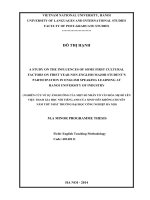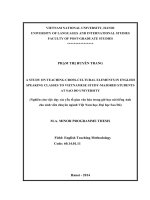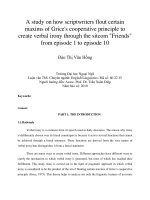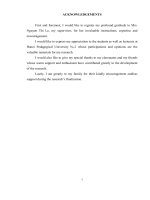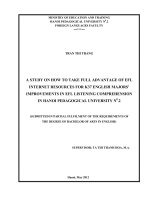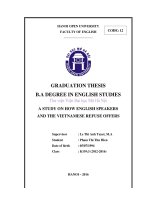A study on how non verbal communication should be used for success in english speaking classes at HPU
Bạn đang xem bản rút gọn của tài liệu. Xem và tải ngay bản đầy đủ của tài liệu tại đây (1.24 MB, 62 trang )
BỘ GIÁO DỤC VÀ ĐÀO TẠO
TRƯỜNG ĐẠI HỌC DÂN LẬP HẢI PHÒNG
-------------------------------
ISO 9001:2015
KHÓA LUẬN TỐT NGHIỆP
NGÀNH: NGÔN NGỮ ANH
Sinh viên: Chiêm Minh Hiếu
Giảng viên hướng dẫn: ThS. Nguyễn Thị Huyền
HẢI PHÒNG – 2018
BỘ GIÁO DỤC VÀ ĐÀO TẠO
TRƯỜNG ĐẠI HỌC DÂN LẬP HẢI PHÒNG
-----------------------------------
A STUDY ON HOW NON-VERBAL COMMUNICATION
SHOULD BE USED FOR SUCCESS IN ENGLISH SPEAKING
CLASSES AT HPU
KHÓA LUẬN TỐT NGHIỆP ĐẠI HỌC HỆ CHÍNH QUY
NGÀNH: NGÔN NGỮ ANH
Sinh viên: Chiêm Minh Hiếu
Giảng viên hướng dẫn:ThS. Nguyễn Thị Huyền
HẢI PHÒNG - 2018
BỘ GIÁO DỤC VÀ ĐÀO TẠO
TRƯỜNG ĐẠI HỌC DÂN LẬP HẢI PHÒNG
--------------------------------------
NHIỆM VỤ ĐỀ TÀI TỐT NGHIỆP
Sinh viên: Chiêm Minh Hiếu
Mã SV: 1412751034
Lớp: NA1801
Ngành: Ngôn ngữ Anh
Tên đề tài: A study on how non-verbal communication should be used for
success in English speaking classes at HPU
NHIỆM VỤ ĐỀ TÀI
1. Nội dung và các yêu cầu cần giải quyết trong nhiệm vụ đề tài tốt nghiệp
( về lý luận, thực tiễn, các số liệu cần tính toán và các bản vẽ).
……………………………………………………………………………..
……………………………………………………………………………..
……………………………………………………………………………..
……………………………………………………………………………..
……………………………………………………………………………..
……………………………………………………………………………..
2. Các số liệu cần thiết để thiết kế, tính toán.
……………………………………………………………………………..
……………………………………………………………………………..
……………………………………………………………………………..
……………………………………………………………………………..
……………………………………………………………………………..
……………………………………………………………………………..
……………………………………………………………………………..
3. Địa điểm thực tập tốt nghiệp.
……………………………………………………………………………..
……………………………………………………………………………..
…………………………………………………………………………….
CÁN BỘ HƯỚNG DẪN ĐỀ TÀI TỐT NGHIỆP
Người hướng dẫn thứ nhất:
Họ và tên:.............................................................................................
Học hàm, học vị:...................................................................................
Cơ quan công tác:.................................................................................
Nội dung hướng dẫn:............................................................................
Người hướng dẫn thứ hai:
Họ và tên:.............................................................................................
Học hàm, học vị:...................................................................................
Cơ quan công tác:.................................................................................
Nội dung hướng dẫn:............................................................................
Đề tài tốt nghiệp được giao ngày
tháng
năm
Yêu cầu phải hoàn thành xong trước ngày
tháng
Đã nhận nhiệm vụ ĐTTN
Đã giao nhiệm vụ ĐTTN
Sinh viên
năm
Người hướng dẫn
Hải Phòng, ngày ...... tháng........năm 2018
Hiệu trưởng
GS.TS.NGƯT Trần Hữu Nghị
PHẦN NHẬN XÉT CỦA CÁN BỘ HƯỚNG DẪN
1. Tinh thần thái độ của sinh viên trong quá trình làm đề tài tốt nghiệp:
……………………………………………………………………………..
……………………………………………………………………………..
……………………………………………………………………………..
……………………………………………………………………………..
……………………………………………………………………………..
……………………………………………………………………………..
……………………………………………………………………………..
……………………………………………………………………………..
2. Đánh giá chất lượng của khóa luận (so với nội dung yêu cầu đã đề ra trong
nhiệm vụ Đ.T. T.N trên các mặt lý luận, thực tiễn, tính toán số liệu…):
……………………………………………………………………………..
……………………………………………………………………………..
……………………………………………………………………………..
……………………………………………………………………………..
……………………………………………………………………………..
……………………………………………………………………………..
……………………………………………………………………………..
……………………………………………………………………………..
3. Cho điểm của cán bộ hướng dẫn (ghi bằng cả số và chữ):
……………………………………………………………………………..
……………………………………………………………………………..
……………………………………………………………………………..
……………………………………………………………………………..
……………………………………………………………………………..
……………………………………………………………………………..
Hải Phòng, ngày … tháng … năm
Cán bộ hướng dẫn
(Ký và ghi rõ họ tên)
CỘNG HÒA XÃ HỘI CHỦ NGHĨA VIỆT NAM
Độc lập - Tự do - Hạnh phúc
PHIẾU NHẬN XÉT CỦA GIẢNG VIÊN HƯỚNG DẪN TỐT NGHIỆP
Họ và tên giảng viên:
...................................................................................................
Đơn vị công tác:
........................................................................ ..........................
Họ và tên sinh viên:
.......................................... Chuyên ngành: ...............................
Đề tài tốt nghiệp:
...................................................................................................
........................................................... ........................................
Nội dung hướng dẫn:
.......................................................... ........................................
....................................................................................................................................
3. Tinh thần thái độ của sinh viên trong quá trình làm đề tài tốt nghiệp
....................................................................................................................................
....................................................................................................................................
....................................................................................................................................
....................................................................................................................................
....................................................................................................................................
4. Đánh giá chất lượng của đồ án/khóa luận (so với nội dung yêu cầu đã đề ra
trong nhiệm vụ Đ.T. T.N trên các mặt lý luận, thực tiễn, tính toán số liệu…)
....................................................................................................................................
....................................................................................................................................
....................................................................................................................................
................................................................................................................................... .
....................................................................................................................................
3. Ý kiến của giảng viên hướng dẫn tốt nghiệp
Được bảo vệ
Không được bảo vệ
Điểm hướng dẫn
Hải Phòng, ngày … tháng … năm ......
Giảng viên hướng dẫn
(Ký và ghi rõ họ tên)
QC20-B18
CỘNG HÒA XÃ HỘI CHỦ NGHĨA VIỆT NAM
Độc lập - Tự do - Hạnh phúc
PHIẾU NHẬN XÉT CỦA GIẢNG VIÊN CHẤM PHẢN BIỆN
Họ và tên giảng viên:
..............................................................................................
Đơn vị công tác:
........................................................................ .....................
Họ và tên sinh viên:
...................................... Chuyên ngành: ..............................
Đề tài tốt nghiệp:
......................................................................... ....................
....................................................................................................................................
............................................................................................................................ ........
1. Phần nhận xét của giáo viên chấm phản biện
....................................................................................................................................
....................................................................................................................................
....................................................................................................................................
....................................................................................................................................
....................................................................................................................................
....................................................................................................................................
2. Những mặt còn hạn chế
....................................................................................................................................
....................................................................................................................................
....................................................................................................................................
....................................................................................................................................
....................................................................................................................................
....................................................................................................................................
3. Ý kiến của giảng viên chấm phản biện
Được bảo vệ
Không được bảo vệ
Điểm phản biện
Hải Phòng, ngày … tháng … năm ......
Giảng viên chấm phản biện
(Ký và ghi rõ họ tên)
QC20-B19
TABLE OF CONTENTS
ACKNOWLEDGEMENTS .............................................................................. 1
ABSTRACT ....................................................................................................... 2
LIST OF TABLES............................................................................................. 3
LIST OF CHARTS ............................................................................................ 4
CHAPTER 1: INTRODUCTION .................................................................... 5
1.1 Rationale .................................................................................................... 5
1.2 Aim of the research ................................................................................. 5
1.3 Objectives of the research ....................................................................... 5
1.4. Research method ....................................................................................... 6
1.4.1 Data collection ..................................................................................... 6
1.4.2 Potential Significance ........................................................................... 6
1.4.3 Organization ......................................................................................... 6
CHAPTER 2: THEORETICAL BASIS OF THE STUDY ............................ 8
2.1 Communication .......................................................................................... 8
2.1.1 Definition of communication ............................................................... 8
2.1.2 Types of communication ...................................................................... 8
2.2 Nonverbal communication ....................................................................... 10
2.2.1. Definition of nonverbal communication............................................ 10
2.2.2. Differences between verbal and nonverbal communication .............. 10
2.2.3. Principles of nonverbal communication ............................................ 12
2.2. 4. Importance of nonverbal communication ......................................... 14
2.2.5. Classification of nonverbal communication ...................................... 14
2.2.6. Levels of communication .................................................................. 16
2.3 Communication skills in teaching ............................................................ 18
2.4. Verbal communication in teaching .......................................................... 18
2.5 Non-verbal communication during teaching ............................................ 19
2.6 The practical application of non-verbal communication in classroom
teaching: ......................................................................................................... 22
CHAPTER 3: RESEARCH METHOD ......................................................... 28
3.1 Selection of subjects ................................................................................. 28
3.2. Research Questions ................................................................................. 28
3.3. Research instrument ................................................................................ 28
3.4. Procedures of data collection ................................................................... 30
3.5. Procedures of data analysis ..................................................................... 31
3.6. Access ..................................................................................................... 31
CHAPTER 4: FINDINGS AND DISCUSSIONS ......................................... 32
4.1. Findings ................................................................................................... 32
4.1.1 Problems during the nonverbal communication between teacher and
students. ...................................................................................................... 32
4.2. Discussions .............................................................................................. 38
4.2.1. Solutions to improve speaking class quality by using non-verbal
communication ............................................................................................ 38
CHAPTER 5: CONCLUSION AND RECOMMENDATION..................... 44
5.1. Summary of the study.............................................................................. 44
5.2 Contribution and Recommendation of the study ...................................... 45
5.2.1. Contribution ...................................................................................... 45
5.2.2. Recommendation of the study ........................................................... 46
5.3. Limitation of the study ............................................................................ 46
5.4. Suggestions for further studies ................................................................ 46
REFERENCES ................................................................................................ 48
APPENDIX STUDENT FOLLOW-UP SURVEY QUESTIONS ................ 51
ACKNOWLEDGEMENTS
I would like to express my heartfelt gratitude to many people who have assisted
me in the completion of my research. First and foremost, I am deeply indebted to my
supervisor, M.A Nguyen Thi Huyen for her patient guidance, critical feedback,
encouragement, and constructive supervision throughout my research.
I would like to thank Mrs. Nguyen Thi To Hoan for her interesting lectures on
cross-cultural communication subject, which provides me general background knowledge
for the research and other teachers in English Department for their great assistance.
I would like to extend my thanks to all of my friends who have always encouraged, assisted
and give me a large number of useful advices during my research.
My gratitude goes to all survey respondents in Hai Phong Private University
who contributed to the data of this research.
The support extended to me by members of my family has been immeasurable. I would like
to express my sincere thanks to my father, my mother, and my brother for their support and
encouragement throughout my study.
Page 1
ABSTRACT
Communication plays a crucial role in our daily lives. To articulate our
ideas, feelings, emotions and skills, we communicate not only with verbal but
also non-verbal methods. These are essential in teaching learning process too.
Teachers can utilize a variety of verbal and non-verbal skills to aid student’s
comprehension of difficult concepts. The use of non-verbal communication is
more than verbal communication, which makes acquisition of its knowledge and
its effective use much more necessary. Many studies show that the quality of
classroom teaching can be improved by effective use of non-verbal
communication. A famous scholar Cooper says that, if a teacher knows how to
use non-verbal communication efficiently, the relationship between the student
and teacher will be improved, and the cognitive ability and learning efficiency
of the students will be developed. The important conclusions that we reach at the
end of this research paper are largely based on the practical observation and
survey implemented by the author at HPU classroom teaching.
Page 2
LIST OF TABLES
Table 1:Comparison between verbal and nonverbal communication
Table 2: Classification of nonverbal communication
Table 3: Frequency of using non-verbal communication in classroom
Table 4:The influence of personality
Page 3
LIST OF CHARTS
Chart 1: Three elements of non-verbal communication
Chart 2: Students’ attitudes towards the importance of non-verbal
communication
Chart 3: The students’ awareness of non-verbal communication that teacher
uses.
Chart 4: Frequency of using non-verbal communication by teachers in class
Chart 5: The outer reason why students rarely use non-verbal communication in
their English classroom.
Chart 6: Percentage of students choosing ways to improve their nonverbal
communication at class
Page 4
CHAPTER 1: INTRODUCTION
1.1 Rationale
Educators rely on verbal communication as a central tool for providing
students with valuable information for academic development. Our daily
nonverbal behaviours reveal who we are and affect how we relate to other
people. Nonverbal communication has implication for the teacher as well as the
learner. It is often said that one can always recognize a language teacher by their
use of gesture in normal conversation. Feldman (1990) asserts that research
regarding the use of non-verbal cues in education demonstrates that educators
often send messages regarding their expectations via non-verbal cues such as
facial expressions and overall body language. These nonverbal cues, according
to Feldman, can have a notable impact on outcomes for student response and
behaviour. With the realization that non-verbal communication can play such an
important role in the process of education, there is a direct impetus to further
examine this issue. Using this as a foundation for investigation, the current
research considers the issue of non-verbal communication between students and
teachers in the context of mitigating and managing conflict. By understanding
these cues, educators can work to improve outcomes when conflict arises with a
student in the classroom.
There is a fact that, teachers often try to use English as much as possible
to teach students in almost English lesson in university. However, a small
number of teachers apply non-verbal communication in English speaking class
resulting in low efficiency. This is also the real issue arising at HPU. Thus, this
study will find out the solutions to make improvement in such class.
1.2 Aim of the research
This study aimed at the importance of non-verbal communication in
English speaking class at HPU
1.3 Objectives of the research
At the end of this thesis, you will be able to:
1. Find out the importance of nonverbal communication in English classes
at HPU
Page 5
2. Give the solutions for improving the quality of English speaking
classes at HPU using nonverbal communication.
1.4. Research method
1.4.1 Data collection
To fulfil this research, the author has to read variety of books and
documents from HPU library. In addition, the documents from internet are very
useful sources to help me complete my thesis on time.
1.4.2 Potential Significance
If teachers are aware of how nonverbal communication use can
specifically benefit their students, they will be better at helping their students to
attain their English language education (McCafferty & Stam, 2008). After
considering this research, teachers may have a better ability to determine how
non-verbal communication use affects language learning in the classroom. They
may better understand the role that non-verbal communication has in the pursuit
of helping students with their goal of second language acquisition. When
teachers contemplate how they should use non-verbal communication, they have
valuable information that can be applied in the classroom.
1.4.3 Organization
The study is designed as follow:
Chapter 1 (Introduction) this part will mention about the reason why the researcher
choose non-verbal communication in teaching as the topic of this research and present the
aim of the research as well as the research method
Chapter 2 (Theoretical basis of the study) provides the readers with theoretical
background related to communication, nonverbal communication in teaching speaking
English. It also highlights the importance of non verbal communication in
classroom.
Chapter 3 (Methodology) outlines the research methods used and demonstrate that
recognized procedures have been followed in the study. In particular, this chapter
describes and justifiesthe procedures employed to select the participants and instruments
Page 6
forthe research as well as specific steps taken to collect data. The explanation of
how the data will be analyzed to address the research questions would be included.
Chapter 4 (Results and discussion) states the results collected from the
instruments, and then the interpretation would be presented. Throughout the
chapter, tables, charts and othersuitable graphic materials would be added to illustrate.
Chapter 5 (Conclusion) contains the summary of the main findings of the study,
the brief limitations of the research and some suggestions for further studies.In
addition, appendices including survey questionnaires for HPU participants
should be attached at the end of the study.
In the following chapter, the research will give an overview about theoretic of
non-verbal communication as well as its role in teaching-learning process.
Page 7
CHAPTER 2: THEORETICAL BASIS OF THE STUDY
2.1 Communication
2.1.1 Definition of communication
Perhaps, communication might well be considered to be one of people’s most
basic activities in daily life. We ourselves probably rarelystopped to think what
“communication” is really about or what we should mean by “communication.”
Until now, there have been quite a few scholars who have proposed their own
definition of communication. Among them, Milton defined“communication” in his
book “Human behavior in organizations: three levels of behavior” (1981) as
basically “the process of transmitting information between two or more persons.”
Berko, Rosenfeld & Samovar(1997, p.6), however, note that “communication is more than
just sending and receiving messages.” It is added that the process of communication needs
“a channel” including “six elements: senders, receivers, messages,a context, a purpose, and
feedback”. Additionally, Brooks & Heath, co-authors of the book “Speech communication
(6th ed.)” released in 1989 claim that communication also means the transmission
of meanings andfeelings through the exchange of verbal and nonverbal messages.
Levine & Adelman (1993) appear to show their agreement with the two abovementioned definitions but they used brief words to define it. Theirconcept of
communication is “the process of sharing meaning throughverbal and nonverbal
behavior” should be generally accepted through out the research.
2.1.2 Types of communication
To take a closer look at the web of expressions that people commitevery day, it
should be noted that the existent types of communication in the world these days
should be understood. The reason for this is that the awareness of the types of
communication could open the person’s mindin comprehending the things happening
in daily life. If a person knowsonly verbal communication but nonverbal
communication, then he couldbe “an alien” in the realm of “emotional communication,”
for example. Knowing the types of communication, therefore, is of vital importance indaily
communication.
Page 8
There is a consensus between Uttara Manohar (2008) and anonline expert team of
writers in terms of types of communication. Ther eare two main types of
communication in their point of view. Based onstyle and purpose of
communication, there can be two broad categories of communication, which are
formal communication and informal communication. Both of them have their own set of
characteristic features. Formal communication occurs in a set formal format such as
atwork, at meetings or all sorts of business communication. The style
of communication in this form is very formal and official as its name; as aresult,
formal communication should be “straight forward, official, and always precise.”
On the other hand, informal communication is just only the way wetalk to each other
daily. Informal means “relaxed” and “casual” so thatthis form of communication often
takes place between friends and familymembers. That is the reason why unlike formal
form, this one “does nothave any rigid rules and guidelines” (Manohar, 2008).
As regards to the base of communication channels, communication is divided into
two other subcategories: verbal and nonverbal communication. As stated in two
online articles: “Types of communication” by Manohar and “Communication” which
are mentioned above, verbal communication consists of “written and oral communication.”
Written communication could use snail mail or email as two means of communication.
An effective writing depends on its style, the use of language, grammar, clarity, and
precision of language. The other type, oral communication refers to the “spoken
words in the communication process.” Meanwhile, Manohar (2008) defines nonverbal
communication as the overall body language of the person who is speaking,
which will include the body posture, the hand gestures, and overall body
movements.
The focus of the research is only nonverbal communication, thus, this type of
communication will be discussed in detail in the following separate part.
Page 9
2.2 Nonverbal communication
2.2.1. Definition of nonverbal communication
There are scores of definitions that researchers and scholars use to define
non-verbal communication.
In the broadest sense, according to Knapp and Hall (2006, p.23), the term
‘nonverbal communication’ is commonly used to describe “all human
communication
events
that
transcend
spoken
interpreted
words.”
Specifically, nonverbal communication behaviours are those bodily actions and
vocal qualities that typically accompany a verbal message. Levine and Adelman
(1993) also define nonverbal communication as “the ‘silent’ language, including
the use of gestures, facial expressions, eye-contact, and conversational
distance.” This definition probably focuses on kinesics – we often call it body
language and just mention a small part of environmental language.
To put it in a simple way, nonverbal communication is everything that is
communicated beyond what is expressed in words.
2.2.2. Differences between verbal and nonverbal communication
Verbal and nonverbal communication is said to be two communication systems
which constitute different languages andoperate according to different laws. When we
communicate person in person, we send not only “discrete, digital, verbal
symbols” butalso “continuous, analogical, nonverbal cues” at the same
time(Brooks & Heath, 1989). However, defining the difference between verbal and
nonverbal communication remains an area of disagreement among experts. Regardless of
this ongoing issue, still, there are some unique characteristics to distinguish two
kinds of communication.
In terms of neurology, neurologists points out that the human nervous
neural handles these two kinds of cues differently. Inparticular, they travel over
different neural pathways in the brain.Nonverbal cues moves in he older parts of the
brain that develop inthe early years before digital information like words and numbersare
learned. Meanwhile, the pathways of the other lie in the portionwhich develops late in the
child.
The speed of reception of nonverbal cues is also different from that of verbal
ones. Analogical messages are received rapidly while digital messages reach us more slowly.
Page 10
Hence nonverbal messages are likely to be perceived and reacted to before the perception of
verbal ones.
There are other differences between verbal and nonverbal behaviours than those of
perception. Brooks and Heath (1989) suggest that “words can and do represent abstractions
such as love and hate”; however, “nonverbal messages observed in one’s behaviour are
more likely to be directly related to the feeling of the moment.” Moreover, as they
propose, most verbal messages are produced “intentionally” because of one’s will where as
nonverbal cues are not easily controlled. The table below by the William Alanson
White Psychiatric Foundation, Inc. quoted by Brooks & Heath (1989, p. 94)
could possibly make the comparison between verbal and nonverbal communication
clearer and easier to understand to readers.
Table 1:Comparison between verbal and nonverbal communication
Nonverbal communication
1
Verbal communication
Nonverbal communication isbased on
Verbal communication is based on
continuous functions; the hand
discontinuous functions; sounds or
iscontinuously involved inmovement.
letters have a discrete beginningand
ending.
2
3
4
Nonverbal communication isregulated Verbal communication is governed
primarily by principles
primarily by arbitrary,
governed biological necessity.
manmade principles.
Nonverbal communication influences
Verbal communicationinfluences
perception,coordination,
thinking and leads to the
and integration, and leads to the
acquisition of information
acquisition of skills
.
Understanding of nonverbal
Understanding of verbal denotation
denotation is based upon the
is based on prior verbal agreement.
participants’ emphatic assessment of
biological similarity; no explanation
Page 11
is needed for understanding what pain is.
5
Nonverbal communicationuses the old
Verbal communication uses younger
structures of thecentral and autonomic brain structures,particularly the cortex.
nervous systems.
6
7
Nonverbal communication islearned
Verbal communication islearned
early in life.
later in life
Action and objects exist in their own
Words do not exist in their own
right.
right. They are arbitrary symbols
representing abstractions or events.
8
9
Nonverbal communication is
Verbal communication is
emotional
intellectual
to a great extent.
to a greater extent.
Nonverbal communication represents
Verbal communication represents
an intimate language.
a distant language.
2.2.3. Principles of nonverbal communication
From those differences between verbal and nonverbal communication above,
three axioms or principles of nonverbal communication could be suggested by
Brooks & Heath in their book “Speech communication” published in 1989.
In their opinion, the fist principle is “one cannot not communicate.” All
behaviours, which can be observed or visible, can bring “message value.” Brooks & Heath
propose that if we do not want to communicate, we can refuse to speak. That means verbal
communication can be avoided; we, however, cannot avoid communicating
nonverbally. Inactivity or silence itself, for example, has its own meaning.
Secondly, feelings and emotions, attitudes and relationships are effectively
communicated
through
nonverbal
behaviours.
Page 12
People
usually
use
verbal
communication – words to share cognitive information and to transmit knowledge,
meanwhile nonverbal cues are best for conveying feelings, emotions and attitudes –
non-cognitive information. Watzlawick, Beavin, Jackson (1967, p.63) add that when
relationship is the central concern of communication (superior-subordinate, leaderfollower, helper-helped...), verbal language is almost meaningless. Brooks & Heath
(1989) explain more as follows:
In courtship, love, or combat, nonverbal communication is the effective
mode. One can, of course, verbally profess love or trust, but these are most
meaningfully communicated through the nonverbal codes. The verbal channel has a
high potential for carrying semantic information, while the nonverbal channel has high
potential for carrying affective information. The emotional side of the message is
very often expressed by the nonverbal elements. When we express a liking or disliking
for a person, we often express it, not only through what we way, but through how we
say it. (p. 95-96)
Berko, Rosenfeld & Samovar (1997) also show theiragreement with Brooks &
Heath when claiming that emotions andfeelings are more accurately and easily
communicated throughnonverbal cues. The possible reason may stem from the fact
thatmost nonverbal ones are innate and unconscious.
Last but not least, “involuntary nonverbal messages are oftenof high
validity” (Brooks & Heath, 1989). It implies that whenverbal and nonverbal
communication conflict, the nonverbalmessages are characteristically the more accurate
reflection of feelings and tend to be more believed. As mentioned above,
verbalcommunication can be manipulated; someone is intent on choosingwords
with care. Meanwhile, as Berko, Rosenfeld, & Samovar(1997) said, “nonverbal behaviors
are often below the level of awareness and are not easily controlled” consciously; as
a result, itcould be hard to distort or deceive nonverbal messages. That is thereason why
nonverbal messages are often regarded as the moreaccurate indicator of feelings and
emotions.
Page 13
2.2. 4. Importance of nonverbal communication
Nonverbal communication plays an important role in ourcommunication
and relationships with others. Those identifiablecharacteristics highlight its
usefulness. In communicating, we tendto emphasize the spoken word or verbal
communication, yet muchof the meaning of a message – 65% or more – is actually
conveyedby
our nonverbal
behaviors
(Birdwhistell,
1970).
To
a great
extent,communication researcher Mehrabian (1981) shows his agreementwith
Birdwhistell when he comes to a conclusion from his findingsthat three elements
of any face-to-face communication accountdifferently for the total meaning of the
message: nonverbal behavior account for 55 %, tone of voice 38 % and words just 7
%.These percents are shown in the chart below:
Chart 1: Three elements of non-verbal communication
Consequently, nonverbal behavior is an important part of helping because of the
large amount of information itcommunicates.
2.2.5. Classification of nonverbal communication
Some forms of non-verbal signals are the same and universaland they have the
same meaning or interpretation. The other forms,nonetheless, are different and have
different meaning too or nomeaning in the other culture. Craig Storti in “Figuring Out”
asquoted by Wienchecki (1999) mentions three main categories of non-verbal
communication in the cross-cultural context. These are:
a. Non-verbal behaviours which exist in your own cultureand in the target culture which
have the same meaning in bothcultures.
Page 14
b. Non-verbal behaviours which exist in both cultures, butwhich are assigned
different meanings in the two cultures.
c. Non-verbal behaviours which have meaning in one culturebut no meaning at all in the
target language.In my view, this classification might be too general. Nguyen (2006)
provides a detailed chart quoted by Do & Dao (2006, p.9) toput nonverbal communication
into two following broad categories:
Table 2: Classification of nonverbal communication
Paralanguage
Extra language
Body language
Object language
Environmental
(kinesics)
(Artifacts)
language
Vocal
+ Eye contact
+ Clothing
+ Setting
characteristics :
+ Gestures
+ Jewellery
+ Conversational
+ Pitch
+ Facial
+ Make-up
distance/ Proxemics
+ Volume
expressions
+ Artificial scents + Time/ Chronemics
+ Rate
+ Postures
+ Flowers
+ Lighting system
+ Vocal quality
+ Touch/
+ Gifts
+Color
+ Types of vocal
Haptics/Tactile
………………
+ Heat
flow
……………
…………….
+ Vocal
interferences
+ Silence
…………
Page 15

